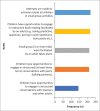A survey of communication supports in Grade R classrooms in the Western Cape, South Africa
- PMID: 36331219
- PMCID: PMC9634850
- DOI: 10.4102/sajcd.v69i1.871
A survey of communication supports in Grade R classrooms in the Western Cape, South Africa
Abstract
Background: Early classroom communication supports are critical in influencing oral language development and emergent literacy skills. It is both support from peers and adults, as well as the environment that impacts the quality and efficacy of language learning. Schools in particular play a key role in communication development, which will be further explored in this article.
Objectives: To describe how communication was being supported in the classroom by teachers in the areas of language-learning environment (LLE), language-learning interactions (LLIs) and language-learning opportunities (LLOs) to focus on classroom communication supports to strengthen literacy outcomes for Grade R learners.
Method: A cross-sectional descriptive survey of classrooms was conducted using a structured observation method in 136 classrooms. The Communication Supporting Classroom Observation Tool was used to make 223 observations across classrooms of LLE (19 items), LLI (20 items) and LLO (5 items). A descriptive analysis of frequency of occurrence of items was conducted for each domain.
Results: Language-learning environment had more frequently occurring observations, with 12 out of 19 items being observed with a frequency of occurrence greater than 65%, indicating that the environment had adequate basic resources (e.g. good light). Language-learning interactions scores indicated that 3 out of 20 items were observed frequently, while 17 out of 20 items were observed less frequently (56.5%), including interactive strategies (e.g. turn-taking). Language Learning Opportunities scores indicated that teacher-led behaviours (e.g. including children in small group activities) were infrequently observed on all items.
Conclusion: While the physical environment was generally supportive, the behaviours in the interactive domains of LLI and LLO were observed less frequently. There is potential for speech-language therapists to work collaboratively with teachers to develop communication supporting classrooms as a critical primary-level intervention for language-literacy learning.
Keywords: Grade R; communication; language; literacy; pre-school.
Conflict of interest statement
The authors declare that they have no financial or personal relationships that may have inappropriately influenced them in writing this article.
Figures
References
-
- Adams-Ojugbele, R., & Moletsane, R. (2019). Towards quality early childhood development for refugee children: An exploratory study of a Grade R class in a Durban child care centre. South African Journal of Childhood Education, 9(1), a616. 10.4102/sajce.v9i1.616 - DOI
-
- Amnesty International . (2020). Amnesty International Report 2020/2021. https://www.amnesty.org/en/documents/pol10/3202/2021/en/
-
- Aronstam, S., & Braund, M. (2016). Play in grade R classrooms: Diverse teacher perceptions and practices. South African Journal of Communication Disorders, 5(3), a242. 10.4102/sajce.v5i3.242 - DOI
-
- Bedore, L.M., Pena, E.D., Fiestas, C., & Lugo-Neris, M.J. (2019). Language and literacy together: Supporting grammatical development in dual language learners with risk for language and learning difficulties. Language, Speech, and Hearing Services in Schools, 51(2), 282–297. 10.1044/2020_LSHSS-19-00055 - DOI - PMC - PubMed
-
- Carolus, S., & Moonsamy, S. (2019). Emergent literacy and language support for ECD children from under-served communities in Gauteng South Africa: A collaborative approach. West Sussex; Per Linguam, 35(2), 280–290. 10.5785/35-2-898 - DOI
MeSH terms
LinkOut - more resources
Full Text Sources




